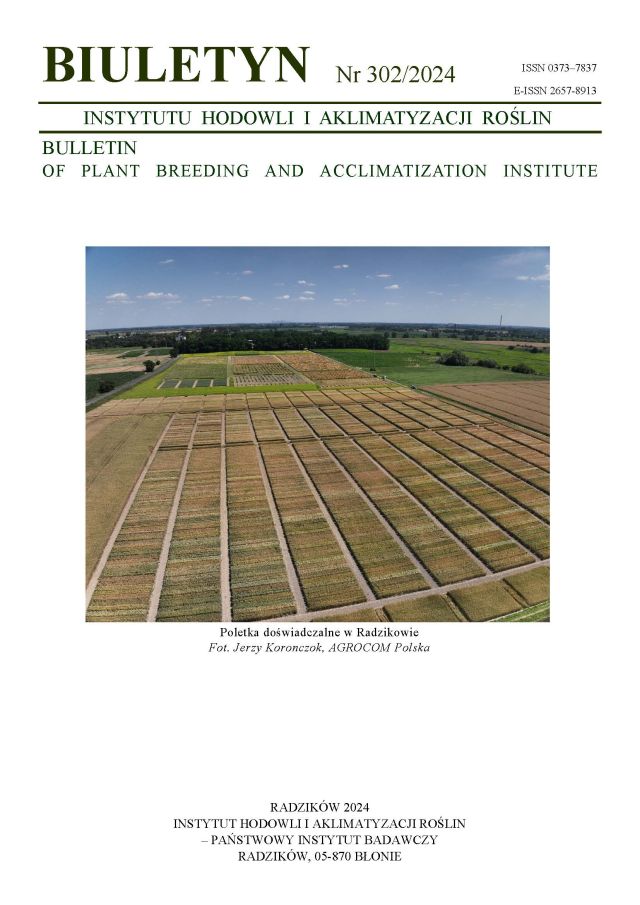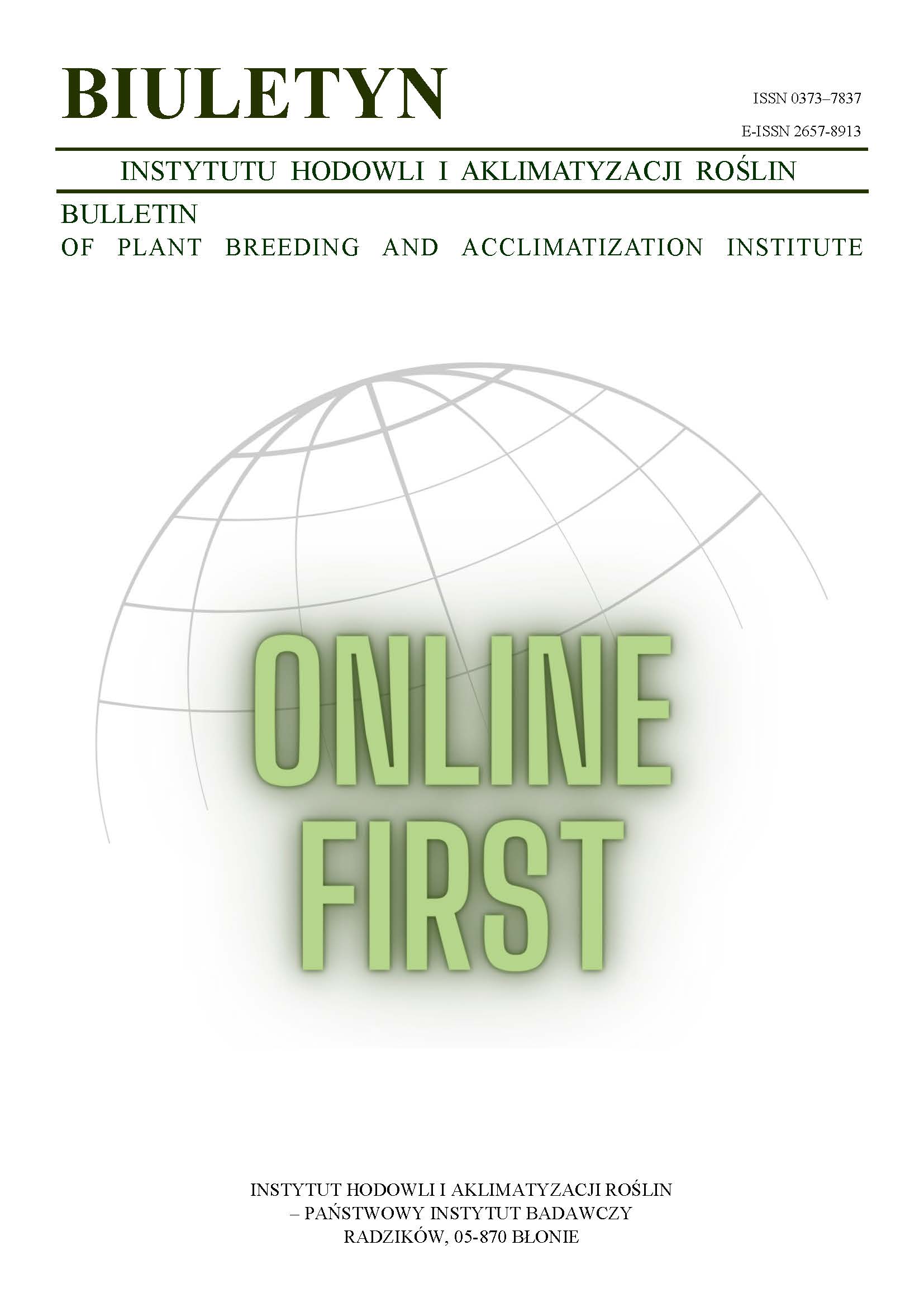Susceptibility of auto- and alloplasmic triticale lines to seedling blight caused by Fusarium culmorum (W.G.Sm.) Sacc.
Tomasz Warzecha
khrin@urk.edu.plKatedra Hodowli Roślin i Nasiennictwa, Akademia Rolnicza w Krakowie (Poland)
Halina Góral
Katedra Hodowli Roślin i Nasiennictwa, Akademia Rolnicza w Krakowie (Poland)
Abstract
Isogenic triticale lines differing in a type of cytoplasm and male fertility (4 male sterile lines with T. timopheevi cytoplasm and 4 maintaining lines with T. aestivum cytoplasm) were examined for susceptibility to seedling blight caused by Fusarium culmorum. Grains of triticale were inoculated with isolate IPO 348-01 originated from the Institute of Plant Protection, Wageningen, the Netherlands. Single isolates of Fusarium culmorum were cultivated on PDA medium (Potato Dextrose Agar- Sigma) on Petri dishes. Inoculated grains were incubated for 7 days at 22°C. Male sterile triticale lines with T. timopheevi cytoplasm showed higher leaf and roots susceptibility to F. culmorum than did male fertile lines with T. aestivum cytoplasm. In the set of male sterile lines, a leaf infection score and root infection score were, respectively, 3 and 1.5 times as high as those in the set of male fertile lines. A coefficient of correlation between leaf and root infection was 0.97. When the male sterility based on T. timopheevi cytoplasm is utilized to produce triticale hybrid varieties, it is advisable to recognise a level of resistance to F. culmorum of female parent lines.
Keywords:
Fusarium culmorum, Triticum timopheevi, triticale, fusarium seedling blightReferences
Bai G., Shaner G. 1994. Scab of wheat: prospects for control. Plant Disease 78: 760.
DOI: https://doi.org/10.1094/PD-78-0760
Google Scholar
Cauderon Y., Cauderon A., Gay G., Roussel J. 1985. Alloplasmic lines and nucleo-cytoplasmic interactions in triticale. In: Proc. Eucarpia Meet. „Genetics and Breeding of Triticale”, Clermont-Ferrand, France, INRA, Paris, 2–5 July 1984: 177 — 191.
Google Scholar
Chełkowski J., Mańka M. 1983. The ability of Fusaria pathogenic to wheat, barley and corn to produce zearalenone. Acta Physiol. Plant 16: 354 — 359.
DOI: https://doi.org/10.1111/jph.1983.106.4.354
Google Scholar
Góral H., Spiss L. 1998. Wpływ sterylizującej cytoplazmy T. timopheevi na cechy rolnicze mieszańców pszenżyta ozimego. Biul. IHAR 205/206: 157 — 161.
Google Scholar
Grey W., Mathre D. E. 1988. Evaluation of spring barley for reaction to Fusarium seedling blight and root rot. Can. J. Plant Sci. 68: 23 — 30.
DOI: https://doi.org/10.4141/cjps88-002
Google Scholar
Jones R.K., Mirocha C. J. 1999. Quality parameters in small grains from Minnesota affected by Fusarium head blight. Plant Disease 83: 506-511.
DOI: https://doi.org/10.1094/PDIS.1999.83.6.506
Google Scholar
Kaul M. L. H. 1988. Male sterility in higher plants. Springer-Verlag, Berlin.
DOI: https://doi.org/10.1007/978-3-642-83139-3
Google Scholar
McMulen M. P., Enz J., Lukach J., Stover R. 1997. Environmental conditions associated with Fusarium head blight epidemics of wheat and barley in the Northern Great Plains, North America. Cereal Res. Commun. 25, 2/3: 777 — 778.
DOI: https://doi.org/10.1007/BF03543843
Google Scholar
Nalepa S. 1990. Hybrid triticale: present and future. In: Proc. 2nd Int. Triticale Symp., Passo Fundo, Rio Grande do Sul, Brazil, 1–5 October 1990: 402 — 407.
Google Scholar
Nalepa S., Jenkins B. C. 1985. The influence of T. timopheevi cytoplasm on endosperm development in triticale. In: Proc. Eucarpia Meet. „Genetics and Breeding of Triticale”, Clermont-Ferrand, France, INRA, Paris, 2–5 July 1984: 193 — 201.
Google Scholar
Miedaner T. 1988. The development of host–pathogen system for evaluating Fusarium resistance in early growth stages of wheat. J. Phytopathol. 121: 23 — 30.
DOI: https://doi.org/10.1111/j.1439-0434.1988.tb00966.x
Google Scholar
Oettler G., Heinrich N., Miedaner T. 2004. Estimates of additive and dominance effects for Fusarium head blight resistance of winter triticale. Plant Breeding 123 (6): 525 — 530.
DOI: https://doi.org/10.1111/j.1439-0523.2004.01010.x
Google Scholar
Panayotov I. 1983. The cytoplasm in Triticinae. In: Proc. 6th Int. Wheat Genet. Symp., Kyoto, Japan, 28 November 3 December 1983: 481 — 497.
Google Scholar
Poehlman J. M., Sleper D. A. 1995. Breeding field crops. Iowa State Univ. Press / Ames.
Google Scholar
Prom L. K., Steffenson B. J., Salas B., Fetch T. G. Jr., Casper H. H. 1997. Barley accessions resistant to Fusarium head blight and the accumulation of deoxynivalenol. Cereal Res. Commun. 25, 3/2: 807 — 808.
DOI: https://doi.org/10.1007/BF03543855
Google Scholar
Salas B., Steffenson B. J., Casper H. H., Prom L. K. 1997. Fusarium species pathogenic to barley and their associated toxins. Cereal Res. Commun. 25, 3/1: 483 — 487.
DOI: https://doi.org/10.1007/BF03543759
Google Scholar
Spiss L., Góral H. 1994. Hodowla form męskosterylnych i przywracających płodność u pszenżyta. Zesz. Nauk. AR w Szczecinie, 162, ser. Rolnictwo, 58: 243 — 246.
Google Scholar
Warzecha R., Salak-Warzecha K. 2002. Hybrid triticale — prospects for research and breeding. Part II: Development of male sterile lines. In: Proc. 5th Int. Triticale Symp., IHAR Radzików, Poland, 30 June 5 July 2002, vol. I: 193 — 198.
Google Scholar
Woś H., Góral H., Woś B., Spiss L. 2002. Heterosis in winter triticale with T. timopheevi cytoplasm. In: Proc. 5th Int. Triticale Symp., IHAR Radzików, Poland, 30 June 5 July 2002, vol. II: 311 — 3.
Google Scholar
Authors
Tomasz Warzechakhrin@urk.edu.pl
Katedra Hodowli Roślin i Nasiennictwa, Akademia Rolnicza w Krakowie Poland
Authors
Halina GóralKatedra Hodowli Roślin i Nasiennictwa, Akademia Rolnicza w Krakowie Poland
Statistics
Abstract views: 107PDF downloads: 26
License
Copyright (c) 2005 Tomasz Warzecha, Halina Góral

This work is licensed under a Creative Commons Attribution-ShareAlike 4.0 International License.
Upon submitting the article, the Authors grant the Publisher a non-exclusive and free license to use the article for an indefinite period of time throughout the world in the following fields of use:
- Production and reproduction of copies of the article using a specific technique, including printing and digital technology.
- Placing on the market, lending or renting the original or copies of the article.
- Public performance, exhibition, display, reproduction, broadcasting and re-broadcasting, as well as making the article publicly available in such a way that everyone can access it at a place and time of their choice.
- Including the article in a collective work.
- Uploading an article in electronic form to electronic platforms or otherwise introducing an article in electronic form to the Internet or other network.
- Dissemination of the article in electronic form on the Internet or other network, in collective work as well as independently.
- Making the article available in an electronic version in such a way that everyone can access it at a place and time of their choice, in particular via the Internet.
Authors by sending a request for publication:
- They consent to the publication of the article in the journal,
- They agree to give the publication a DOI (Digital Object Identifier),
- They undertake to comply with the publishing house's code of ethics in accordance with the guidelines of the Committee on Publication Ethics (COPE), (http://ihar.edu.pl/biblioteka_i_wydawnictwa.php),
- They consent to the articles being made available in electronic form under the CC BY-SA 4.0 license, in open access,
- They agree to send article metadata to commercial and non-commercial journal indexing databases.
Most read articles by the same author(s)
- Stefan Stojałowski , Marta Orłowska , Martyna Sobczyk , Anna Bienias , Marcin Berdzik , Beata Myśków , Halina Góral , Magdalena Simlat , Tomasz Warzecha , Wojciech Wesołowski , Marek Szklarczyk , Mirosław Pojmaj , Genetic background of male sterility in triticale with different cytoplasm’s and perspectives of it utilization for development of CMS system in wheat , Bulletin of Plant Breeding and Acclimatization Institute: No. 286 (2019): Special issue
- Halina Góral, Male fertility of winter triticale depending on the cytoplasm and male parent , Bulletin of Plant Breeding and Acclimatization Institute: No. 269 (2013): Regular issue
- Halina Góral, Maciej Ejsmond, Combining ability analysis and heritability of yield components in linseed (Linum usitatissimum L.) , Bulletin of Plant Breeding and Acclimatization Institute: No. 249 (2008): Regular issue
- Halina Góral, Mirosław Pojmaj, Renata Pojmaj, Monika Burczy, Production of hybrid seeds of winter triticale from cms and restoring lines in strip and bulk sowing , Bulletin of Plant Breeding and Acclimatization Institute: No. 252 (2009): Regular issue
- Zygmunt Kaczmarek, Tomasz Warzecha, Tadeusz Adamski, Maria Surma, Multivariate approach to estimation of reduction of yield components in hulless and hulled DH lines of barley inoculated with Fusarium culmorum , Bulletin of Plant Breeding and Acclimatization Institute: No. 226/227 (2003): Regular issue
- Tomasz Warzecha, Tadeusz Adamski, Zygmunt Kaczmarek, Maria Surma, Gene effects on susceptibility of naked and hulled barley doubled haploids to Fusarium culmorum head blight , Bulletin of Plant Breeding and Acclimatization Institute: No. 226/227 (2003): Regular issue
- Halina Góral, Mirosław Pojmaj, Renata Pojmaj, Frequency of maintainer and restorer genotypes for the cms-T. timopheevi system winter triticale , Bulletin of Plant Breeding and Acclimatization Institute: No. 244 (2007): Regular issue
- Elżbieta Pisulewska, Julita Maciejewicz-Ryś, Halina Góral, Yield, chemical composition and protein quality in long flower head forms of red clover (Trifolium pratense L.) , Bulletin of Plant Breeding and Acclimatization Institute: No. 228 (2003): Regular issue
- Halina Góral, Jadwiga Przypadek, Ludwik Spiss, Selection of red clover (Trifolium pratense L.) with regard to length and number of flower heads , Bulletin of Plant Breeding and Acclimatization Institute: No. 226/227 (2003): Regular issue
- Halina Góral, Ludwik Spiss, Development of maintainer and restorer genotypes for cms-T. timopheevi system in spring triticale , Bulletin of Plant Breeding and Acclimatization Institute: No. 236 (2005): Regular issue














